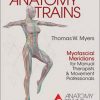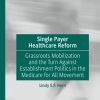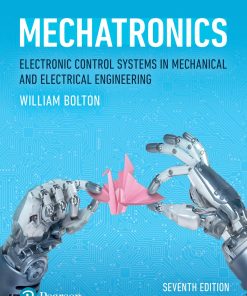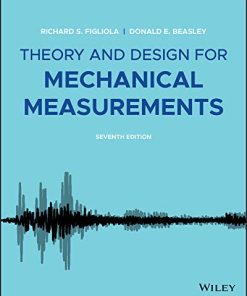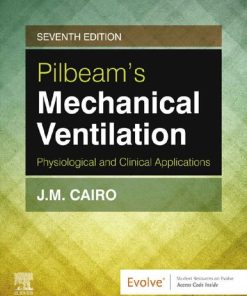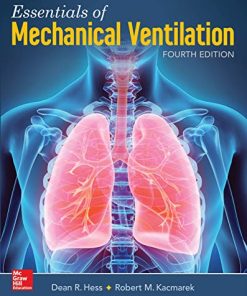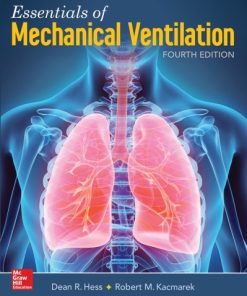Pilbeams Mechanical Ventilation 7th Edition by James Cairo 0323571093 9780323571098
$50.00 Original price was: $50.00.$25.00Current price is: $25.00.
Pilbeam’s Mechanical Ventilation 7th Edition by James M. Cairo – Ebook PDF Instant Download/DeliveryISBN: 0323571093, 9780323571098
Full download Pilbeam’s Mechanical Ventilation 7th Edition after payment.
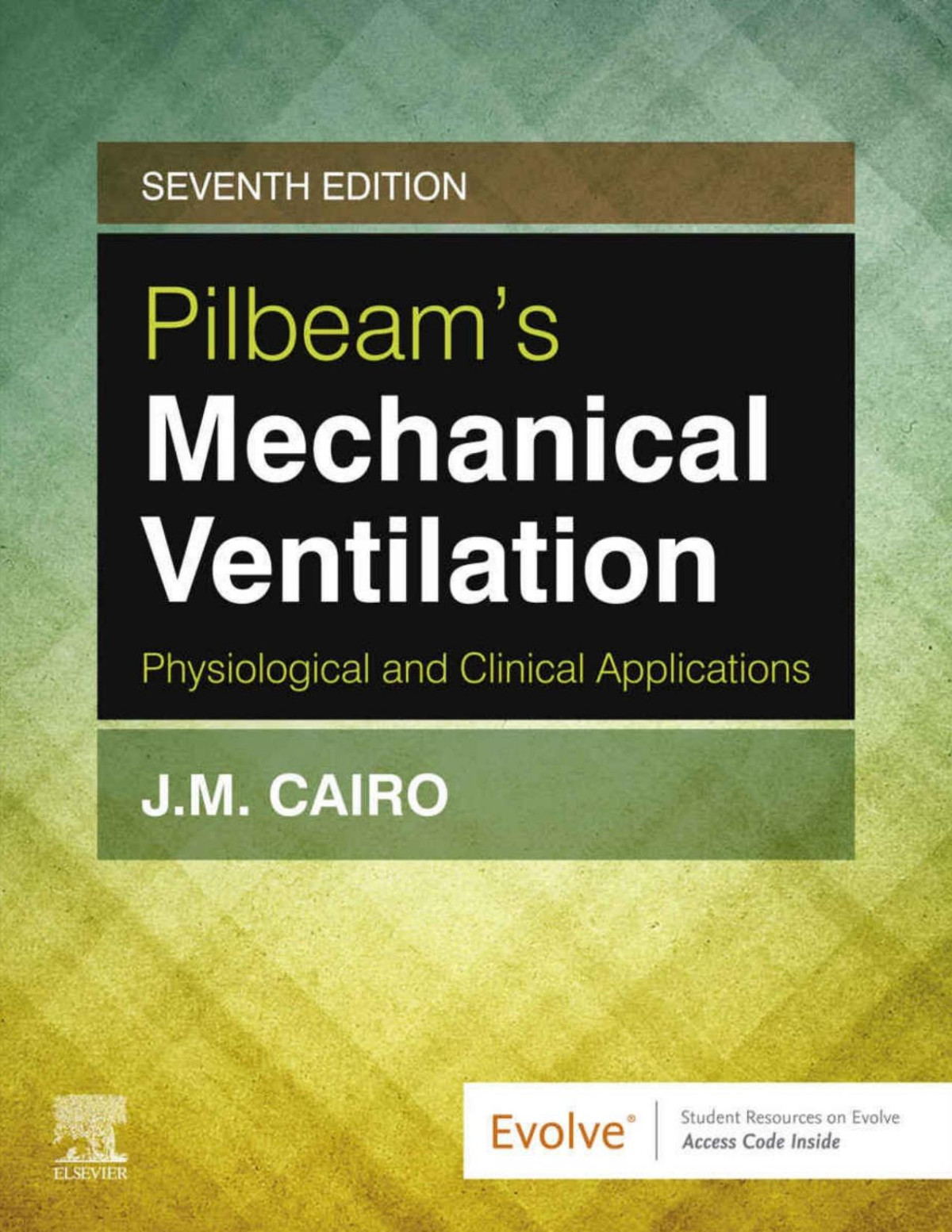
Product details:
ISBN-10 : 0323571093
ISBN-13 : 9780323571098
Author : James M. Cairo
Ensure you understand one of the most sophisticated areas of respiratory care with Pilbeam’s Mechanical Ventilation: Physiological and Clinical Applications, 7th Edition! Known for its simple explanations and in-depth coverage of patient-ventilator management, this evidence-based text walks you through the most fundamental and advanced concepts surrounding mechanical ventilation and helps you understand how to properly apply these principles to patient care. This new edition is an excellent reference for all critical care practitioners and features coverage of the physiological effects of mechanical ventilation on different cross sections of the population. Additionally, student-friendly features promote critical thinking and clinical application — such as key points, AARC clinical practice guidelines, critical care concepts, updated learning objectives which address ACCS exam topics and are currently mandated by the NBRC for the RRT-ACCS credential.
Pilbeam’s Mechanical Ventilation 7th Table of contents:
Chapter 1. Basic Terms and Concepts of Mechanical Ventilation
Physiological Terms and Concepts Related to Mechanical Ventilation
Normal Mechanics of Spontaneous Ventilation
Lung Characteristics
Time Constants
Types of Ventilators and Terms Used in Mechanical Ventilation
Types of Mechanical Ventilation
Definition of Pressures in Positive Pressure Ventilation
Summary
Chapter 2. How Ventilators Work
Historical Perspective on Ventilator Classification
Internal Function
Power Source or Input Power
Control Systems and Circuits
Power Transmission and Conversion System
Summary
Chapter 3. How a Breath Is Delivered
Basic Model of Ventilation in the Lung During Inspiration
Factors Controlled and Measured During Inspiration
Overview of Inspiratory Waveform Control
Phases of a Breath and Phase Variables
Types of Breaths
Summary
Chapter 4. Establishing the Need for Mechanical Ventilation
Acute Respiratory Failure
Patient History and Diagnosis
Physiological Measurements in Acute Respiratory Failure
Overview of Criteria for Mechanical Ventilation
Possible Alternatives to Invasive Ventilation
Summary
Chapter 5. Selecting the Ventilator and the Mode
Noninvasive and Invasive Positive Pressure Ventilation: Selecting The Patient Interface
Full and Partial Ventilatory Support
Breath Delivery and Modes of Ventilation
Modes of Ventilation
Bilevel Positive Airway Pressure
Additional Modes of Ventilation
Summary
Chapter 6. Initial Ventilator Settings
Determining Initial Ventilator Settings During Volume-Controlled Ventilation
Initial Settings During Volume-Controlled Ventilation
Setting The Minute Ventilation: Special Considerations
Inspiratory Pause During Volume Ventilation
Determining Initial Ventilator Settings During Pressure Ventilation
Setting Baseline Pressure: Physiological Positive End-Expiratory Pressure
Summary
Chapter 7. Final Considerations in Ventilator Setup
Selection of Additional Parameters and Final Ventilator Setup
Sensitivity Setting
Alarms
Periodic Hyperinflation or Sighing
Final Considerations In Ventilator Equipment Setup
Selecting the Appropriate Ventilator
Evaluation of Ventilator Performance
Chronic Obstructive Pulmonary Disease
Asthma
Neuromuscular Disorders
Closed Head Injury
Acute Respiratory Distress Syndrome
Acute Cardiogenic Pulmonary Edema and Congestive Heart Failure
Summary
Chapter 8. Initial Patient Assessment
Documentation of The Patient–Ventilator System
The First 30 Minutes
Monitoring Airway Pressures
Vital Signs, Blood Pressure, and Physical Examination of The Chest
Management of Endotracheal Tube and Tracheostomy Tube Cuffs
Monitoring Compliance and Airway Resistance
Comment Section of The Ventilator Flow Sheet
Summary
Chapter 9. Ventilator Graphics
Relationship of Flow, Pressure, Volume, and Time
A Closer Look at Scalars, Curves, and Loops
Using Graphics to Monitor Pulmonary Mechanics
Assessing Patient–Ventilator Asynchrony
Advanced Applications
Summary
Chapter 10. Assessment of Respiratory Function
Noninvasive Measurements of Blood Gases
Capnography (Capnometry)
Exhaled Nitric Oxide Monitoring
Transcutaneous Monitoring
Indirect Calorimetry and Metabolic Measurements
Assessment of Respiratory System Mechanics
Measurements
Summary
Chapter 11. Hemodynamic Monitoring
Review of Cardiovascular Principles
Obtaining Hemodynamic Measurements
Interpretation of Hemodynamic Profiles
Clinical Applications
Summary
Chapter 12. Methods to Improve Ventilation in Patient–Ventilator Management
Correcting Ventilation Abnormalities
Common Methods of Changing Ventilation Based on Paco2 and Ph
Airway Clearance During Mechanical Ventilation
Secretion Clearance From an Artificial Airway
Administering Aerosols to Ventilated Patients
Types of Aerosol-Generating Devices
Postural Drainage and Chest Percussion
Flexible Fiberoptic Bronchoscopy
Additional Patient Management Techniques and Therapies in Ventilated Patients
Fluid Balance
Psychological and Sleep Status
Patient Safety and Comfort
Transport of Mechanically Ventilated Patients Within an Acute Care Facility
Summary
Chapter 13. Improving Oxygenation and Management of Acute Respiratory Distress Syndrome
Basics of Oxygenation Using FIO2, PEEP Studies, and Pressure–Volume Curves for Establishing Optimal PEEP
Introduction to Positive End-Expiratory Pressure and Continuous Positive Airway Pressure
Peep Ranges
Indications for PEEP and CPAP
Initiating PEEP Therapy
Selecting The Appropriate PEEP/CPAP Level (Optimal PEEP)
Use of Pulmonary Vascular Pressure Monitoring with PEEP
Contraindications and Physiological Effects of PEEP
Weaning from PEEP
Acute Respiratory Distress Syndrome
Pathophysiology
Changes in Computed Tomogram with ARDS
ARDS as an Inflammatory Process
PEEP and the Vertical Gradient in ARDS
Lung-Protective Strategies: Setting Tidal Volume and Pressures in ARDS
Long-Term Follow-Up on ARDS
Pressure–Volume Loops and Recruitment Maneuvers in Setting PEEP in ARDS
Summary of Recruitment Maneuvers in ARDS
The Importance of Body Position During Positive Pressure Ventilation
Additional Patient Cases
Summary
Chapter 14. Ventilator-Associated Pneumonia
Epidemiology
Pathogenesis of Ventilator-Associated Pneumonia
Diagnosis of Ventilator-Associated Pneumonia
Treatment of Ventilator-Associated Pneumonia
Strategies to Prevent Ventilator-Associated Pneumonia
Summary
Chapter 15. Sedatives, Analgesics, and Paralytics
Sedatives and Analgesics
Summary
Chapter 16. Extrapulmonary Effects of Mechanical Ventilation
Effects of Positive Pressure Ventilation on the Heart and Thoracic Vessels
Adverse Cardiovascular Effects of Positive Pressure Ventilation
Factors Influencing Cardiovascular Effects of Positive Pressure Ventilation
Beneficial Effects of Positive Pressure Ventilation on Heart Function in Patients With Left Ventricular Dysfunction
Minimizing the Physiological Effects and Complications of Mechanical Ventilation
Effects of Mechanical Ventilation on Intracranial Pressure, Renal Function, Liver Function, and Gastrointestinal Function
Renal Effects of Mechanical Ventilation
Effects of Mechanical Ventilation on Liver and Gastrointestinal Function
Nutritional Complications During Mechanical Ventilation
Summary
Chapter 17. Effects of Positive Pressure Ventilation on the Pulmonary System
Lung Injury With Mechanical Ventilation
Effects of Mechanical Ventilation on Gas Distribution and Pulmonary Blood Flow
Respiratory and Metabolic Acid–Base Status in Mechanical Ventilation
Air Trapping (Auto-PEEP)
Hazards of Oxygen Therapy With Mechanical Ventilation
Increased Work of Breathing
Ventilator Mechanical and Operational Hazards
Complications of the Artificial Airway
Summary
Chapter 18. Troubleshooting and Problem Solving
Definition of the Term Problem
Protecting the Patient
Identifying the Patient in Sudden Distress
Patient-Related Problems
Ventilator-Related Problems
Common Alarm Situations
Use of Graphics to Identify Ventilator Problems
Unexpected Ventilator Responses
Summary
Chapter 19. Basic Concepts of Noninvasive Positive Pressure Ventilation
Types of Noninvasive Ventilation Techniques
Goals of and Indications for Noninvasive Positive Pressure Ventilation
Other Indications for Noninvasive Ventilation
Patient Selection Criteria
Equipment Selection for Noninvasive Ventilation
Setup and Preparation for Noninvasive Ventilation
Monitoring and Adjustment of Noninvasive Ventilation
Aerosol Delivery in Noninvasive Ventilation
Complications of Noninvasive Ventilation
Discontinuing Noninvasive Ventilation
Patient Care Team Concerns
Summary
Chapter 20. Weaning and Discontinuation From Mechanical Ventilation
Weaning Techniques
Methods of Titrating Ventilator Support During Weaning
Closed-Loop Control Modes for Ventilator Discontinuation
Evidence-Based Weaning
Evaluation of Clinical Criteria for Weaning
Recommendation 1: Pathology of Ventilator Dependence
Recommendation 2: Assessment of Readiness for Weaning Using Evaluation Criteria
Recommendation 3: Assessment During a Spontaneous Breathing Trial
Recommendation 4: Removal of the Artificial Airway
Factors in Weaning Failure
Nonrespiratory Factors that may Complicate Weaning
Recommendation 6: Maintaining Ventilation in Patients with Spontaneous Breathing Trial Failure
Final Recommendations
Recommendation 8: Weaning Protocols
Recommendation 9: Role of Tracheostomy in Weaning
Recommendation 10: Long-Term Care Facilities for Patients Requiring Prolonged Ventilation
Recommendation 11: Clinician Familiarity with Long-Term Care Facilities
Recommendation 12: Weaning in Long-Term Ventilation Units
Ethical Dilemma: Withholding and Withdrawing Ventilatory Support
Summary
Chapter 21. Long-Term Ventilation
Goals of Long-Term Mechanical Ventilation
Sites for Ventilator-Dependent Patients
Patient Selection
Preparation for Discharge to The Home
Follow-Up and Evaluation
Equipment Selection for Home Ventilation
Complications of Long-Term Positive Pressure Ventilation
Alternatives to Invasive Mechanical Ventilation at Home
Expiratory Muscle AIDS and Secretion Clearance
Tracheostomy Tubes, Speaking Valves, and Tracheal Buttons
Ancillary Equipment and Equipment Cleaning for Home Mechanical Ventilation
Summary
Chapter 22. Neonatal and Pediatric Mechanical Ventilation
Recognizing the Need for Mechanical Ventilatory Support
Goals of Newborn and Pediatric Ventilatory Support
Noninvasive Respiratory Support
Conventional Mechanical Ventilation
High-Frequency Ventilation
Weaning and Extubation
Adjunctive Forms of Respiratory Support
Summary
Chapter 23. Special Techniques Used in Ventilatory Support
Airway Pressure Release Ventilation
Other Names
Advantages of Airway Pressure Release Compared with Conventional Ventilation
Disadvantages
Initial Settings21,32,33
Adjusting Ventilation and Oxygenation21,32,33
Discontinuation
High-Frequency Oscillatory Ventilation in the Adult
Technical Aspects
Initial Control Settings
Indication and Exclusion Criteria
Monitoring, Assessment, and Adjustment
Adjusting Settings to Maintain Arterial Blood Gas Goals
Returning to Conventional Ventilation
Heliox Therapy and Mechanical Ventilation
Gas Flow Through the Airways
Heliox in Avoiding Intubation and During Mechanical Ventilation
Postextubation Stridor
Devices for Delivering Heliox in Spontaneously Breathing Patients
Manufactured Heliox Delivery System
Heliox and Aerosol Delivery During Mechanical Ventilation
Monitoring the Electrical Activity of the Diaphragm and Neurally Adjusted Ventilatory Assist
Review of Neural Control of Ventilation
Diaphragm Electrical Activity Monitoring
Neurally Adjusted Ventilatory Assist
People also search for Pilbeam’s Mechanical Ventilation 7th:
pilbeam’s mechanical ventilation 8th edition
pilbeam’s mechanical ventilation 8th edition pdf
susan pilbeam mechanical ventilation
pilbeam’s mechanical ventilation workbook answer key
pilbeam’s mechanical ventilation pdf
Tags: Pilbeams, Mechanical, Ventilation, James Cairo
You may also like…
Engineering - Mechanical Engineering & Dynamics
Engineering - Mechanical Engineering & Dynamics
Theory and Design for Mechanical Measurements 7th Edition Richard S. Figliola
Business & Economics - Management & Leadership
M Management 7th Edition by Thomas Bateman 126420955X 9781264209552
Psychology - Cognitive Psychology
Psychology - Psychological Disorders


